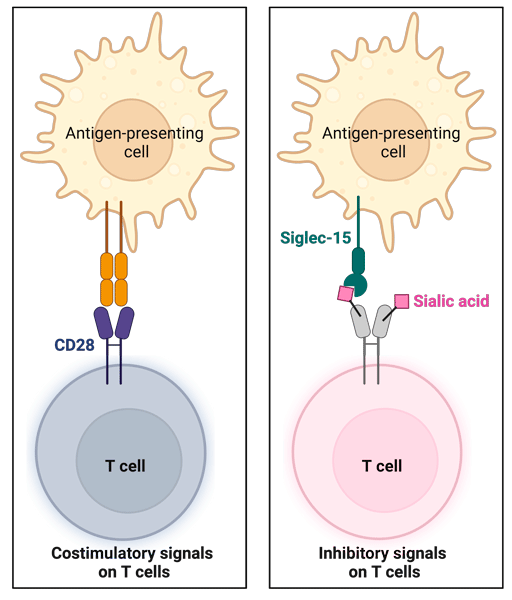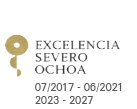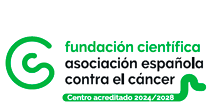
2025/03/26
Unlocking new immunotherapies: CD28 and Siglec-15 receptors in cancer
The CD28 project, funded by the European Union, has advanced our understanding of T cell regulation in the tumor microenvironment.
Researchers have proposed blocking Siglec-15 receptor with modified sialic acids to restore T cell function.
Artificial intelligence could accelerate the development of treatments targeting Siglec-15, opening new therapeutic possibilities.
Immunotherapy has made significant progress in recent years, particularly in the regulation of T cells, which are fundamental to the immune system. T cells are essential for defending the body against infections and tumor cells. To be activated properly, they require a primary signal from antigen-presenting cells (APCs), such us dendritic cells. However, this signal alone is insufficient. A second signal from co-stimulatory receptors, with CD28 being one of the most important, is necessary. CD28, by binding to its ligands CD80 and CD86, facilitates T cell activation, promoting their proliferation and strengthening the immune response.
However, in many cases, tumor cells develop mechanisms that inhibit T cell activity, allowing them to escape immune surveillance. One such mechanism is the increased presence of sialic acid residues on the surface of cancer cells. These monosaccharides, present in many glycoproteins displayed on the cell membrane, interfere with CD28 activation and other co-stimulatory receptors, hindering the immune system's ability to recognize and attack tumor cells.
In this context, the project “Probing CD28 as checkpoint for T cell co-stimulation in cancer and infection”, funded by the European Union through the EXCELLENT SCIENCE - Marie Skłodowska-Curie Actions program and awarded to Dr. Pablo Valverde, has been coordinated by CIC bioGUNE, member of BRTA, under the supervision of Ikerbasque researchers Jesús Jiménez-Barbero and June Ereño-Orbea. This project has made significant strides in understanding how CD28's function is modulated, opening new possibilities for developing more effective treatments for cancer and chronic infections.
A crucial aspect of this project has been investigating how sialic acids interfere with CD28 activation. For years, it had been observed that enzymatically removing sialic acid residues from cells significantly increased T cell activation. However, experiments conducted by the research team, in close collaboration with Prof. Paulson (Scripps Research Institute, La Jolla, USA), revealed that there are not any direct interactions between CD28 and the sialylated glycans, thus prompting the exploration of alternative modulation pathways.
As the investigations delved deeper into immune system regulation, the spotlight was focused on Siglec-15, a key receptor that plays a crucial role in immune evasion in cancer. Siglec-15 is part of the Siglec family of receptors that recognize sialic acids. This receptor is expressed on tumor-associated macrophages and has the ability to inhibit T cell responses in the tumor microenvironment, thus facilitating immune evasion.
Structural and molecular recognition studies conducted during the project revealed that Siglec-15 can recognize various configurations of sialic acid, enhancing its function as an inhibitor of T cell activity. This discovery offers a new therapeutic strategy: blocking Siglec-15 to restore T cell's ability to attack tumor cells.
This finding has significant implications for developing new cancer therapies. Researchers are now working on designing synthetic ligands that can block Siglec-15's action. These ligands, either alone or in combination with other anti-tumor agents, could enhance the immune system´s ability to eliminate cancer cells.
The design also involves the use of artificial intelligence methodologies to accelerate the drug development process targeting Siglec-15. With these advanced drug design tools, scientists expect identifying molecules with high affinity for this receptor, allowing for faster development of new treatments. This combination of molecular biology with advanced technologies promises to transform how drugs are designed, improving the accessibility and effectiveness of immunological therapies.
The findings of this project have provided new perspectives on T cell regulation, particularly how sialic acid and Siglec-15 affect their activation.
For more information about the project and all results, you can consult public documents and publications available on CORDIS and other Horizon framework resources.
About CIC bioGUNE
The Centre for Cooperative Research in Biosciences (CIC bioGUNE), member of the Basque Research & Technology Alliance (BRTA), located in the Bizkaia Technology Park, is a biomedical research organisation conducting cutting-edge research at the interface between structural, chemical, molecular and cell biology, with a particular focus on generating knowledge on the molecular bases of disease, for use in the development of new diagnostic methods and advanced therapies.
About Ikerbasque
Ikerbasque - Basque Foundation for Science - is the result of an initiative of the Department of Education of the Basque Government that aims to reinforce the commitment to scientific research by attracting, recovering and consolidating excellent researchers from all over the world. Currently, it is a consolidated organization that has over 350 researchers/s, who develop their work in all fields of knowledge.
About BRTA
BRTA is an alliance of 4 collaborative research centres (CIC bioGUNE, CIC nanoGUNE, CIC biomaGUNE y CIC energiGUNE) and 13 technology centres (Azterlan, Azti, Ceit, Cidetec, Gaiker, Ideko, Ikerlan, Leartiker, Lortek, Neiker, Tecnalia, Tekniker y Vicomtech) with the main objective of developing advanced technological solutions for the Basque corporate fabric.
With the support of the Basque Government, the SPRI Group and the Provincial Councils of the three territories, the alliance seeks to promote collaboration between the research centres, strengthen the conditions to generate and transfer knowledge to companies, contributing to their competitiveness and outspreading the Basque scientific-technological capacity abroad.
BRTA has a workforce of over 4,000 professionals, executes 22% of the Basque Country's R&D investment, registers an annual turnover of more than 300 million euros and generates 100 European and international patents per year.

See a large version of the first picture





